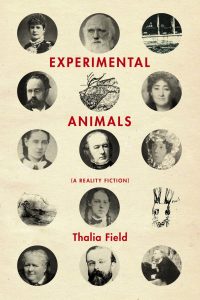by Ben Murphy
Experimental Animals (A Reality Fiction)
by Thalia Field. NY: Solid Objects, 2016. pp. 264
The parenthetical subtitle of Thalia Field’s new book reads like a fallacious marketing designation—a label slapped on to tease the booksellers who have to figure out where to stock this slippery little creature. Is it fiction or nonfiction? Well, it’s both, so shelve it in your “reality fiction” section. Still stumped? Maybe it’s easier to heed the first half of the title—something of a pun—and simply call it “experimental”: experimental literature about experimenting on animals.
Of course, the book isn’t so much about experimenting on animals as it is about people at loggerheads over the issue of whether or not animals should be used in experiments. More precisely, Experimental Animals follows Claude Bernard, the famous 19th century French physiologist who made prodigious and often gruesome use of animals, and his much less famous wife, the avante la lettre animal rights activist, Fanny Bernard. What begins as inter-marital tension grows to entangle other parties and broader cultural issues related to science, art, politics, ethics, activism, feminism (and misogyny), and history.
The book unfolds through a collage of sources: Fanny’s first-person narration, newspaper clippings, quotes from books and manuscripts—including Claude’s published and unpublished writings—and personal letters penned by and to historical figures ranging from the immediately recognizable (Victor Hugo, Émile Zola, Charles Darwin, etc.) to the relatively unknown. This, apparently, is what Field means by “reality fiction”: a heady brew of archival sourcing and creative license, a documentary aesthetic set to the pulse of inventive pathos and plot.
We begin with a newspaper account of Claude’s death only to backtrack to the beginning of his doomed marriage. Claude, a floundering dramatist and up-and-coming scientist, marries Fanny for a dowry that funds his work in physiology. Claude’s ‘cutting-edge’ methods include vivisection and poison injection, and when applied together they amount to what one admirer quoted in the book calls “a living autopsy,” a pat euphemism ill-befitting the mutilated dogs, cats, rabbits, frogs (etc.) that mewl and writhe throughout Experimental Animals. Indeed, prompted initially by cries of pain echoing from Claude’s laboratory—a possible reference by Field to the turning point of H.G. Wells’ classic The Island of Dr. Moreau—Fanny’s disgust with Claude’s unremitting methods spur her to rescue would-be vivisected animals. This is the book at its most vivid: when animals are shown to suffer or, more comically, when Claude squabbles in the midnight streets of Paris with his wife as she (and eventually his daughters, too) smuggle dogs and cats out from under his poised scalpel. After divorce, the standoff balloons as Claude continues his work and Fanny throws her support into a rising tide of anti-vivisection fervor. When the book returns to where it begins, with Claude’s death, we learn about the “afterlife” of his reputation as well as the delightful irony of his highly marketable scientific success: his daughters promote his masterwork, Introduction to the Study of Experimental Medicine, for use in schools because they and their mother are entitled to royalties; these royalties are immediately channeled into the anti-vivisection causes that Claude’s career—and his masterwork itself—oppose.
Like all experimental work, Experimental Animals is writing that will make you think about how you read. It is nettling as a reader to be made to wonder where facts become fiction, and vice versa. But even the reader predisposed to like books that chafe convention will find whole threads here that defy cohesion and tax patience. The occasional Greek mythology, for instance, never falls fully into orbit, and many of the longer excerpts from newspapers, treatises, and personal letters similarly distract in tangents that never bend back to our main cast of characters (a cast that is itself too sprawling to keep in view).
But if Field’s approach falters at moments and wanders at others, the overall effect is startling. The sheer range of voices invoked and Field’s expert point-counterpoint strategy of pitting the impassioned, sometimes hilarious words of rivals and enemies directly against one another evokes the zeitgeist of its mid-to-late 19th century setting: Paris, a city besieged by political upheaval and military invasion even as its salon elites marshaled science against sentiment and rationality against romance.
And if Field succeeds in rendering a truly dynamic cultural tableau, the even more rewarding layer of Experimental Animals delivers when the book reflects on its own methods and meanings. One passage is exemplary in this regard. After wandering in and out passages from Zola—a figure who dominates much of the latter half of the novel—Field’s narration reads: “In a fictionalism of facts—a factualism—the fait-alisme—the story accretes from facts, from news, from research, from local gossip—until this facticity—an encyclopedic record of information—provides not just a ‘slice’ of life but the whole thing” (203). For Zola, building a story through the accretion of “facts” is a description of what he called the “experimental novel.” Drawing extensively and explicitly from Bernard’s Introduction, Zola hailed a naturalist fiction that would follow in the footsteps of the master’s method: careful observation and controlled experimentation. But if Field is paraphrasing Zola’s perspective, her mention of an accretive “encyclopedic record of information” also, of course, describes Experimental Animals itself. Thus, if this passage expresses Zola’s dream of accurately reproducing the world through a faithfully rendered fiction, it also points to Field’s significantly more fragmented version of making art imitate nature. Zola presumes to get at more than a mere “slice” of life; Field counters that it is precisely through slicing—through the smooth excision of documents, characters, and conversation—that an accurate depiction of life emerges. That Field’s subject matter is also a matter of slicing—into history and animals alike—is part of what makes Experimental Animals fascinating on the level of meta-commentary.
There is quite a bit not mentioned here, and perhaps the most powerful element that needs to be addressed, if only briefly, is the book’s overarching interest in asking where we draw the line between humans and animals. The novel suggests that this line usually partitions Man from other, whether the latter is rendered as nonhuman animal, woman, or slave. In making this charge, Field’s work enters into any number of conversations about animal rights, ecological politics, feminist historiography, and postcolonial critique. But in choosing creative work as her outlet, she writes about experiments through experiment, and, with the flair that this fresh approach affords, she vivifies a historical cross-section in which the “experimental animal[s]” of her title correspond to stray dogs, maverick scientists, and renegade wives alike.



